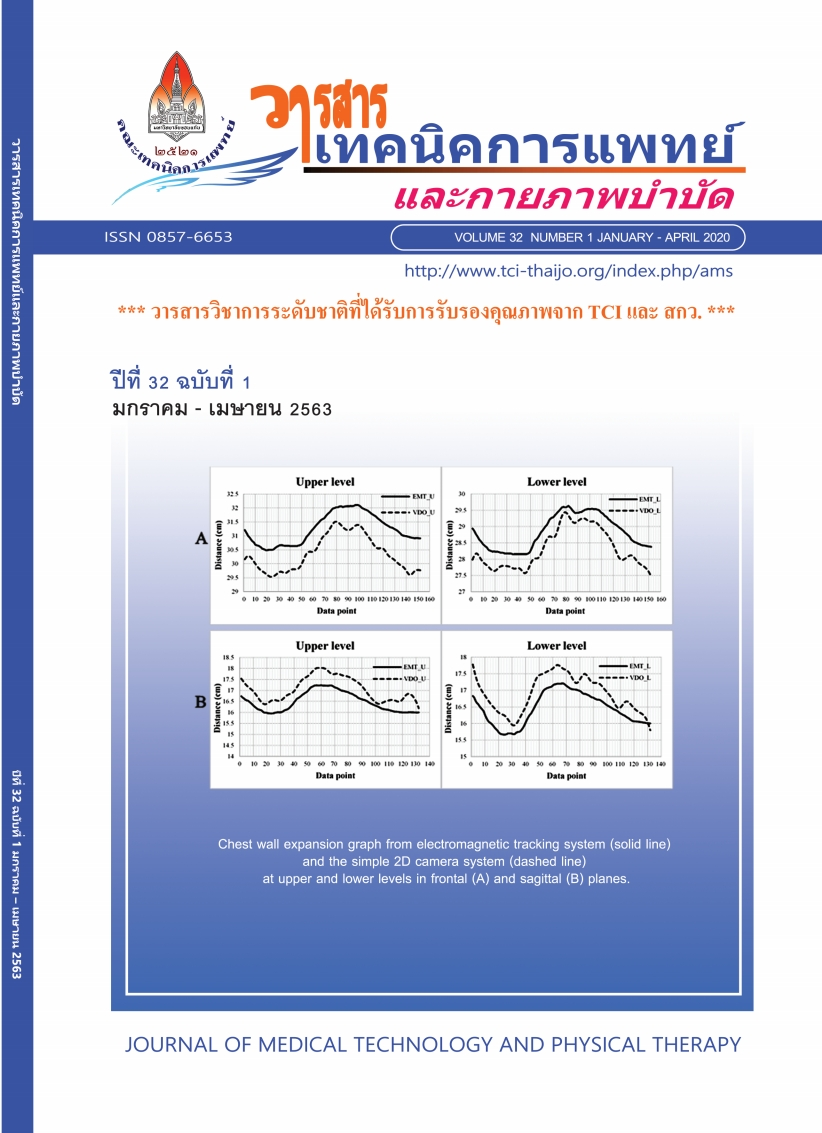Association between G6PD, HMOX1 and BLVRA variants and severity of hyperbilirubinemia in northeastern Thai neonates
Main Article Content
Abstract
Neonatal hyperbilirubinemia is a common disorder that is associated with a variety of factors, especially genetic factors. This study aimed to examine the prevalence of G6PD, HMOX1 (GT-repeats) and BLVRA (rs699512; A>G) variants and their association with the severity of neonatal hyperbilirubinemia in northeastern Thai neonates. A total of 271 neonates with hyperbilirubinemia were analyzed for G6PDmutation, HMOX1 (GT-repeats) and BLVRA (rs699512; A>G) polymorphisms by multiplex AS-PCR, fragment analysis and PCR-RFLP, respectively. The prevalence of G6PD mutation, HMOX1 (short GT repeats) and BLVRA (rs699512; A>G) polymorphisms were found in 55.7%, 62.3% and 42.1% of subjects, respectively. The present study showed that the G6PD mutation, HMOX1 (< 23 GT-repeats) and BLVRA (rs699512; A>G) polymorphisms were significant risk factors for developing severe neonatal hyperbilirubinemia. Therefore, neonates with severe hyperbilirubinemia should be investigated for the G6PD mutation or HMOX1 (< 23 GT-repeats) or BLVRA (rs699512; A>G) polymorphisms.
Article Details
References
Porter ML, Dennis BL. Hyperbilirubinemia in the term newborn. Am Fam Physician 2002; 65(4): 599-606.
Keren R, Luan X, Friedman S, Saddlemire S, Cnaan A, Bhutani VK. A comparison of alterna-tive risk-assessment strategies for predicting significant neonatal hyperbilirubinemia in term and near-term infants. Pediatrics 2008; 121(1): 170-9.
Watchko JF, Lin Z. Exploring the genetic architecture of neonatal hyperbilirubinemia. Semin Fetal Neonatal Med 2010; 15(3): 169-75.
Kaplan M, Hammerman C. Neonatal screening for glucose-6-phosphate dehydrogenase deficiency: biochemical versus genetic tech-nologies. Semin Perinatol 2011; 35(3): 155-61.
Li Y, Wu T, Chen L, Zhu Y. Associations between G6PD, OATP1B1 and BLVRA variants and susceptibility to neonatal hyperbilirubinaemia in a Chinese Han population. J Paediatr Child Health 2019; 55(9): 1077-83.
Kitcharoen S, Dechyotin S, Khemtonglang N, Kleesuk C. Relationship among glucose-6-phosphate dehydrogenase (G-6-PD) activity, G-6-PD variants and reticulocytosis in neonates of northeast Thailand. Clin Chim Acta 2015; 442: 125-9.
Maines MD, Trakshel GM, Kutty RK. Character-ization of two constitutive forms of rat liver microsomal hemeoxygenase. Only one molecular species of the enzyme is inducible. J Biol Chem 1986; 261(1): 411–9.
Katayama Y, Yokota T, Zhao H, Wong RJ, Stevenson DK, Taniguchi-ikeda M, et al. Association of HMOX1 gene promoter polymorphisms with hyperbilirubinemia in the early neonatal period. Pediatr Int 2015; 57(4): 645-9.
Ahmad Z, Salim M, Maines MD. Human Biliverdin Reductase Is a Leucine Zipper-like DNA-binding Protein and Functions in Transcriptional Activation of Heme Oxygenase-1 by Oxidative Stress. J Biol Chem 2002; 277 (11): 9226–32.
Lin R, Wang X, Wang Y, Zhang F, Wang Y, Fu W, et al. Association of polymorphisms in four bilirubin metabolism genes with serum bilirubin in three Asian populations. Hum Mutat 2009; 30(4): 609–15.
Tiwari PK, Sethi A, Basu S, Raman R, Kumar A. Heme oxygenase-1 gene variants and hyperbilirubinemia risk in North Indian newborns. Eur J Pediatr 2013; 172(12): 1627–32.
Yang H, Wang Q, Zheng L, Lin M, Zheng X Bin, Lin F, et al. Multiple genetic modifiers of bilirubin metabolism involvement in significant neonatal hyperbilirubinemia in patients of Chinese descent. PLoS One 2015; 10(7): 1–16.
Weng YH, Chiu YW, Cheng SW, Yang CY. Risk assessment of gene variants for neonatal hyperbilirubinemia in Taiwan. BMC Pediatr 2016; 16(1): 144.
Khemtonglang N, Kitcharoen S, Kiatchoosakun P, Dechyothin S, Kleesuk C. Relationship between glucose-6-phosphate dehydrogenase deficiency and ugt1a1 genotypes in neonates with hyperbilirubinemia. Southeast Asian J Trop Med Public Health 2017; 48(3): 655-61.
American Academy of Pediatrics Subcommittee on H. Management of hyperbilirubinemia in the newborn infant 35 or more weeks of gestation. Pediatrics 2004; 114(1): 297-316.
Sakunthai K. Phenotypic and genotypic characteristics of glucose-6-phosphate dehydrogenase deficiency in female neonates with hyperbilirubinemia. [Master’s Thesis]. Graduate School, Khon Kaen University: 2018.
Maisels MJ. Neonatal jaundice. Pediatr Rev 2006; 27(12): 443-54.
Kaplan M, Hammerman C. Glucose-6-phos-phate dehydrogenase deficiency and severe neonatal hyperbilirubinemia: a complexity of interactions between genes and environment. Semin Fetal Neonatal Med 2010; 15(3): 148-56.
Huang CS, Hung KL, Huang MJ, Li YC, Liu TH, Tang TK. Neonatal jaundice and molecular mutations in glucose-6-phosphate dehydrogenase deficient newborn infants. Am J Hematol 1996; 51(1): 19-25.
Kaplan M, Algur N, Hammerman C. Onset of jaundice in glucose-6-phosphate dehydroge-nase-deficient neonates. Pediatrics 2001; 108(4): 956-9.
Kaplan M, Rubaltelli FF, Hammerman C, Vilei MT, Leiter C, Abramov A, et al. Conjugated bilirubin in neonates with glucose-6-phosphate dehydrogenase deficiency. J Pediatr 1996; 128(5): 695-7.
Yamada N, Yamaya M, Okinaga S, Nakayama K, Shibahara S, Sasaki H. Microsatellite polymorphism in the heme oxygen- ase-1 gene promoter is associated with susceptibility to emphy- sema. Am. J Hum Genet 2000; 66: 187–95.
Kanai M, Akaba K, Sasaki A, Sato M, Harano T, Shibahara S, et al. Neonatal Hyperbilirubinemia in Japanese Neonates : Analysis of the Heme Oxygenase-1 Gene and Fetal Hemoglobin Composition in cord blood.Pediatr Res 2003; 54(2): 165-71.
Yasuda H, Okinaga S,Yamaya M. Association of susceptibil- ity to the development of pneumonia in the older Japanese popu- lation with haem oxygenase-1 gene promoter polymorphism. J Med Genet 2006; 43: 17.
Stern L, Khanna NN, Levy G, Yaffe SJ. Effect of phenobarbital on hyperbilirubinemia and glucuronide formation in newborns. Am J Dis Child 1970; 120: 26-31.


